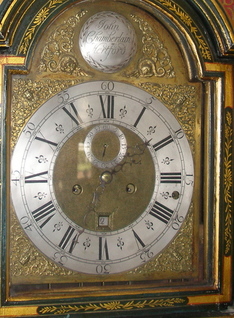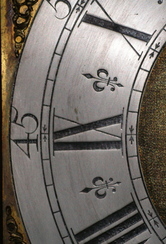|
|
In this Forum we discuss the silver of the United Kingdom, as well as British Colonial silver and Old Sheffield Plate. Past British - Irish Sterling topics/threads worth a look. |
|
|
| How to Post Photos | Want to be a Moderator? |
|
|
In this Forum we discuss the silver of the United Kingdom, as well as British Colonial silver and Old Sheffield Plate. Past British - Irish Sterling topics/threads worth a look. |
|
|
| How to Post Photos | Want to be a Moderator? |

|
 SMP Silver Salon Forums SMP Silver Salon Forums
  British / Irish Sterling British / Irish Sterling
  Clock faces Clock faces
|
| next newest topic | next oldest topic |
| Author | Topic: Clock faces |
|
ahwt Posts: 2377 |
  
 This happens to be an English clock, but the question is for all clocks that are said to have a silver dial. If the dial on the face is silver why does it not tarnish? And why does the brass surround not tarnish? Are the metals really silver and brass or some other metal? The clockmaker for this clock was John Chamberlain and it is my understanding that he would not have made the case, but would he have made the face? IP: Logged |
|
Scotia Posts: 125 |
  
Hi, I am no expert but I believe most clock faces are silvered i.e. plated and also lacquered which prevents the metals from tarnishing but changes the colour slightly. IP: Logged |
|
swarter Moderator Posts: 2920 |
  
Scotia is correct - the brass and silver surfaces would have been lacquered, as was the practice at the time for all instruments, scientific, mathematical and philosophical, that were made of those metals. Clockmakers rarely made more than the movements themselves, and sometimes not even those, many being only assemblers. Dials and cases were made by specialist craftsmen, either within the clockmakers shop or bought in from outside suppliers. The later in time, the less likely it was that one man made the entire thing. Cases were often not signed by their makers; dials and movements were; the name prominently displyed on the dial face may be nothing more than that of the retailer and/or assembler. Again. the later the date, the less likely the signature is of the maker of more than the movement, if even that. [This message has been edited by swarter (edited 03-02-2005).] IP: Logged |
|
ahwt Posts: 2377 |
  
The book on Missouri silver by Norman Mack has a short appendix that discusses how to clean silver. Jo Ann Griffin, a former objects conservator at the Dallas Museum of Arts, recommends lacquer as a means to prevent tarnishing once the object is free of tarnish. I did not think that lacquer would be so durable on silver or brass, but I should have known as lacquer was often used on furniture and now we all want that original finish. I still would think that lacquer would not be appropriate on silver that is actually being used as any break in the lacquer would allow the tarnishing process to begin and then to clean the silver one would have to remove the lacquer. IP: Logged |
|
nihontochicken Posts: 289 |
  
Nice clock! I hope to acquire an early-mid eighteenth century brass dial longcase clock someday myself (when I hit the Lotto, I guess). Yes, the silver-colored chapter ring on brass dial clocks is actually silvered brass. This was done long before the advent of electroplating by use of a chemical paste to deposit the silver. Here is one formula for said paste: 1 part silver chloride The paste is rubbed on the cleaned brass, and the silver is reduced and deposited on the brass surface. This method yields a mat finish that is particularly pleasing. Unfortunately, brass dials gave way in popular taste to painted dials around 1780 or so, at which time the workmanship in general seems to have gone into decline, perhaps as clocks lost their attraction as magical machines and became mere household appliances. To me, the old brass dial longcase clocks are still quite magical. IP: Logged |
|
ahwt Posts: 2377 |
  
Thanks for the great information. That a paste was used to put down a layer of silver is fascinating. I vaguely remember that there was also something the French did before either the Sheffield process or electroplating was invented. I think they actually used sheets of pure silver that were somehow attached to a base metal, but I did not know of the method you note. I do recall that black wax was dripped into the recessed numbers and other decoration on the silvered portion on the face of the clock so as to highlight the numbers. Clocks are still magical to me and if I forget to wind one I know something is missing. It is very easy to get used to their pleasant sounds and know something is wrong if they don’t chime or ding. Thank again. Art IP: Logged |
|
swarter Moderator Posts: 2920 |
  
The previous method described could be likened to gilding. Thin sheets of silver were also burnished onto brass in a manner somewhat similar to sheffield plating (which was beaten rather than burnished, or at least burnished as a last step). The reason scratchy black lines often appear in the silver following the curve of the chapter rings is that scratching from fingernails as the hands were repeatedly reset resulted in removal of the lacquer where the fingernails dragged on the surface (and sometimes silver), and subsequent tarnishing of the exposed metal. Lacquer on brass was pigmented to appear golden, which gave a richer color than clear lacquer; that on silver was clear. Lacquer on metal surfaces only lasts if handling is kept to a minimum. On surveying and other instruments used in the field, and others subject to frequent handling, the parts most often handled were finished with a black oxidized surface, which gave better protection to the metal. IP: Logged |
|
ahwt Posts: 2377 |
  
 This shows the clock face a little clearer and as Scotia, Nihontochicken and Swarter indicated the matte silver finish, that was lacquered many years ago, now has black lines tracing the many fingers that moved the hands. These long pendulum clocks keep great time, but occasionally the hands need adjustment. Thanks for the great information. IP: Logged |
All times are ET | next newest topic | next oldest topic |
  |
|
Ultimate Bulletin Board 5.46a
|
1. Public Silver Forums (open Free membership) - anyone with a valid e-mail address may register. Once you have received your Silver Salon Forum password, and then if you abide by the Silver Salon Forum Guidelines, you may start a thread or post a reply in the New Members' Forum. New Members who show a continued willingness to participate, to completely read and abide by the Guidelines will be allowed to post to the Member Public Forums. 2. Private Silver Salon Forums (invitational or $ donation membership) - The Private Silver Salon Forums require registration and special authorization to view, search, start a thread or to post a reply. Special authorization can be obtained in one of several ways: by Invitation; Annual $ Donation; or via Special Limited Membership. For more details click here (under development). 3. Administrative/Special Private Forums (special membership required) - These forums are reserved for special subjects or administrative discussion. These forums are not open to the public and require special authorization to view or post. |
|
copyright © 1993 - 2022
SM Publications
All Rights Reserved. Legal & Privacy Notices |